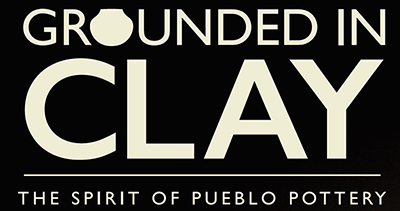Jason Garcia
Tewa/Santa Clara Pueblo
Curator Jason Garcia/Okuu Pin (Tewa/Santa Clara Pueblo) is a potter, ceramicist, printmaker, painter, father, son, brother, uncle, and an alumnus of the universities of New Mexico and Wisconsin.
Jason chose the following for the Grounded in Clay exhibit:
Avanyu: Water Serpent
Initially, I wanted to select work that represents my Pueblo heritage of Kha’p’o Owingeh (Santa Clara Pueblo, or SCP), P’osuwaegeh Owingeh (Pojoaque Pueblo), and Ohkay Owingeh (formerly San Juan Pueblo). I even viewed pots from both Santa Clara and Pojoaque in the SAR collection. As a potter/ceramicist/printmaker/artist and an enrolled tribal member from SCP, however, I ultimately decided to focus solely on SCP pottery.
Having viewed the pottery that other participants chose, I noticed that there were several “classic” and “traditional” Santa Clara pots: black polished water jars and wedding vases, some with a carved bear paw and water designs, all fired using the reduction process. For my own clay work, I make exclusive use of polychrome mineral pigment paints that may or may not change color after the piece undergoes the traditional Pueblo pottery firing process. My maternal grandmother, Petra M. Gutierrez, favored this style of decoration, as did her daughters Minnie Vigil (my godmother), Thelma Talachy, and Lois Gutierrez-De La Cruz. Each inspired me to carry on the polychrome tradition in my own work.
The two pieces I chose are a jar and a vase, both of which feature the water serpent Avanyu. Avanyu is often portrayed on SCP pottery, symbolizing water. Avanyu may represent heavy flooding after a torrential storm and also the gentle, soft flow of a river or stream. Avanyu is often seen on the ceremonial kilts of Pueblo buffalo dancers. Avanyu appears in various forms on pottery, as seen here, but also on rock art, and is even represented on the SCP’s official tribal seal and on its casino chips.
The jar has a highly burnished coating of red iron-oxide paint. Its design is painted in two different mineral pigments, white and red-orange. The two serpents face each other and are separated at the head and the tail by a terraced cloud with lightning emanating from each side, mimicking the lightningbolt tongue emerging from the mouth of each Avanyu. The serpents’ bodies are painted in matte red-orange iron oxide and outlined in white mineral pigment. The pot was overfired, and various smoke clouds appeared on the vessel, changing the effect of the painted designs.
The vase, a mother–son collaboration between Lela and Luther Gutierrez, is a polychrome vessel painted in mineral pigments. It was awarded the grand prize at the 1963 Santa Fe Indian Market. The neck features a singular Avanyu that is representative of the style created by Evangelio “Van” Gutierrez, Luther’s father and brother of my paternal greatgrandmother, Severa Tafoya. On the body of the vessel are interlocking bird motifs that resemble cranes, along with triangular shapes including symbols of mountains, clouds, moisture, and various seasonal changes. The colors painted on the vase range from various shades of red to orange, brown, cream, and green, all outlined in black.
This style of polychrome is extremely influential in my own ceramic work, and inspires me to explore and experiment with different color pigments.


